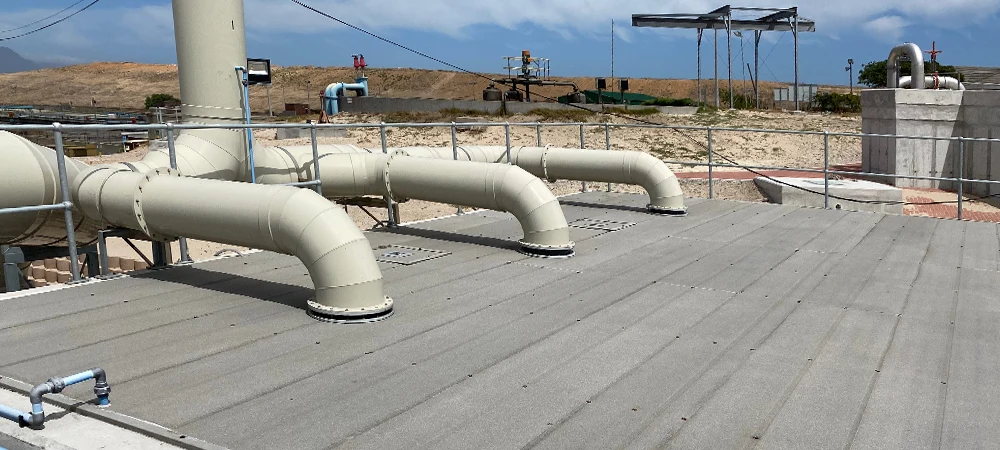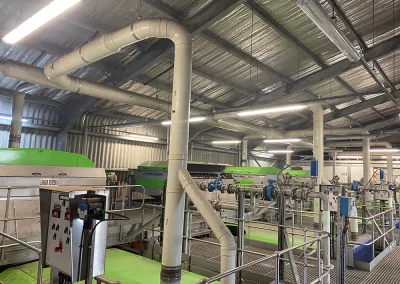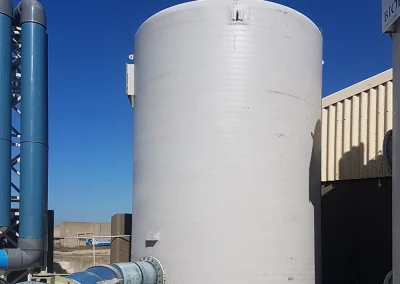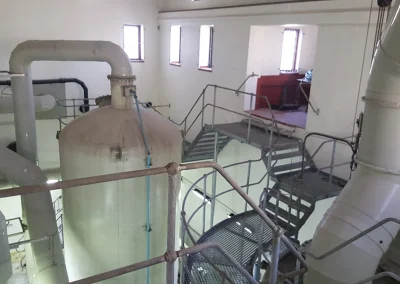Increasingly, odour complaints feature on management agendas at wastewater treatment facilities.
There are a number of reasons for this. As urban areas expand, distances between municipal wastewater treatment plants and neighbours decrease. The capacities of wastewater treatment plants have not kept up with increased demand and plants are routinely overloaded. Collection systems have been widened to include growing towns and cities, resulting in longer sewer lines, causing increased septicity. The collection, conveyance and treatment of municipal wastewater present a number of challenges that must be managed in order to minimise the impact on neighbours. Controlling odours is one of these management challenges.
Aerobic wastewater contains a variety of odour-causing compounds such as organic acids, esters, alcohols, aldehydes as well as indole and skatole. Also, when oxygen is consumed in the wastewater, due to extended detention times and high organic loading, anaerobic areas develop and release odours at a much greater rate. Hydrogen sulphide and other organic sulphides such as methyl mercaptan (MM), dimothyl sulphide (DMS), and dimethyl disulphide (DMDS) have very low detection thresholds and can lead to health and safety issues.
Characteristics of odour
A general understanding of odour and the properties of odorants and their perception is useful for understanding the implications for odour abatement technologies.
Airstreams can contain spectrums of odorants each with their own unique characteristics.
The key parameters or characteristics of interest for odour control systems are:
- water solubility
- molecular weight
- molecular structure
- vapour pressure
- odour detection threshold.
These parameters all have a direct impact on the availability and degradability of the compounds, as well as their potential to cause an off-site negative impact upon surrounding communities.
The major groups of odorants that require consideration are:
- hydrogen sulphide
- organic sulphides
- ammonia and nitrogen compounds
- VOCs.
Hydrogen sulphide
Hydrogen sulphide is generated through anaerobic decomposition of the organic material contained within the wastewater. It is a colourless, toxic gas that has a characteristic odour of rotting eggs. Hydrogen sulphide is heavier than air, contributes to corrosion of infrastructure and can be immediately dangerous to life and health above concentrations of 100 ppmv. It is soluble in water and is readily biodegradable in biological systems. The odour detection is reported to be as low as 5 ppb.
Organic sulphides
These complex molecules are also produced as a by-product of anaerobic decomposition of organic materials present in the wastewater. A diverse group of higher molecular weight compounds such as methyl mercaptan, ethyl mercaptan, dimethyl disulphide, and dimethyl sulphide are garnering more and more attention for ensuring all odours are effectively contained and treated at wastewater treatment plants. These compounds have a wide variety of solubilities and characteristic odours ranging from rancid, skunk-like to decayed cabbage. These compounds, other than methyl mercaptan, tend to be more recalcitrant to biodegration and have very low detection thresholds. Detection thresholds can be as low as 0.03 ppb.
Ammonia and nitrogen compounds
As organic material in wastewater is degraded, ammonia, amines and other nitrogen-bearing compounds will be released. These compounds tend to be highly water soluble and readily biodegradable.
VOCs
There are many other potential odour contributors that can be released from treatment processes. These vary greatly in composition and their impact on the corresponding selection of abatement equipment. Organic acids such as aceticand butyric acid are readily biodegradable. Aldehydes, ketones and aliphatics may also be present in the airstream. The composition and concentration of these components are a function of the raw sewage sources. While these compounds are typically overpowered by the sulphur-bearing, and to a lesser extent, nitrogen-bearing compounds present in the air stream, they are becoming increasingly more important as consideration for optimised odour control applications in sensitised urban environments.
Odour emissions for individual wastewater unit treatment processes
The characteristics of the odours that are emitted from the various types of wastewater unit treatment processes vary considerably in terms of constituents and concentrations.
Wastewater treatment processes can be classified into three main segments: collection, liquid-phase treatment and residuals or biosolids treatment. While biological technologies are robust and flexible, not every application can be addressed appropriately with a single technology. Knowing when and how to use a technology is a critical element in the successful implementation of an odour control strategy.
Odour treatment technologies used to control odours rely on the following processes: biological, chemical, electro/chemical, thermal or physical and selection depends on the following factors:
- chemical and physical characteristics of odorants
- required removal performance
- space available
- maintenance requirements
- capital cost
- life-cycle cost
- influent concentrations
- variability of loading.
Biological systems
With biological systems, micro-organisms are used to biodegrade odorants into simple compounds. The odorants are first absorbed into a water film that contains microbes. The microbes metabolise the pollutants in order to obtain energy and nutrients. Perhaps, because this process is similar to the process used to treat wastewater, biological filters are outstripping competing technologies on municipal wastewater treatment plants.
Biological systems either employ organic or inorganic media and are divided into biotrickling filters, biofilters or combinations thereof. Systems can either be open or closed. A closed system is preferable because of improved control of the factors affecting performance.
Modern biological systems use inorganic media because the media usually does not require replacement and lower pressure losses mean savings in energy consumption. Biological systems can treat airflows with variable odorant loadings. Biological systems require water sup- ply and drainage points.
Physical process
The most common example is a carbon adsorber where foul air is passed through a virgin or impregnated carbon bed. The odorous substance is physically captured in or on the carbon. Advantages of carbon adsorption are its ability to capture a wide range of odorants and low energy requirements. Disadvantages are high running costs because the carbon has to be replaced (especially in case of high odorant loadings), humid air can affect the adsorption process when the media is saturated, breakthrough is sudden and the spent media is toxic and has to disposed of in landfills for hazardous materials. Carbon is sometimes used as the final stage in a multi-stage odour control system to remove traces of remaining odorants.
Thermal systems
Thermal energy is used to oxidise odorants. Although thermal systems are effective, the high energy costs result in very few being found in wastewater treatment plants.
Chemical systems
The most widely used examples for treatment of wastewater odours are wet scrubbers. Odorants are dissolved in water that usually contains a reactant. The major advantage of wet scrubbers is that a short retention time results in a compact footprint. Negatives are an inability to cope with fluctuating odorant loadings and the effluent is toxic where oxidants are used. With airstreams where multiple odorants are present, a series of scrubbing vessels using different reactants and operating at different pH levels are required.
Electrochemical systems
Ultraviolet or photocatalytic oxidation is used to convert odorants to a non-odorous state. With photocatalytic oxidation, UV lamps are used in conjunction with a catalyst surface. The catalyst surface becomes active in the presence of UV light. The odorant is adsorbed onto the catalyst surface and then decomposed similar to catalytic oxidation. Advantages are a small footprint, no water or drain is required, low maintenance requirements and low energy consumption. However, the UV lamps and catalyst must be replaced at regular intervals.





